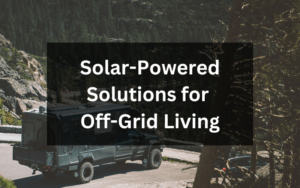Struggling to find reputable solar power fans for greenhouse needs? Look no further. This article presents a straightforward and versatile solution: solar generators. Here, we cover everything you need to know about using solar generators to power your greenhouse fans and other devices. We’ll guide you through understanding solar generators, how they function, and how to select the right one for your greenhouse. Plus, we’ll share our top three solar generator picks to suit any need – whether you’re looking for high power, mid-range efficiency, or budget-friendly options.
Table of Contents
Where Can I Get Solar Power Fans?
Searching for solar power fans (and heaters) for your greenhouse can be a challenging task. One big problem many buyers face is the scarcity of reputable brands that offer these products directly through their websites. Often, solar-powered fans and heaters appear on platforms like Amazon, sold by various vendors, with less-than-desirable product reviews. This can be a big turn-off to potential buyers, due to the perceived risk associated with making such a purchase from unknown sellers – especially given the typically high costs of these products.
If you’re reading this, chances are you’re experiencing this very same problem. There simply aren’t enough reputable brands in the US, UK, and elsewhere which offer solar-powered fans to put customers’ minds at ease. So, what’s the solution?

Using Solar Generators to Power your Greenhouse Fan
We suggest turning to solar generators as a robust and flexible alternative. The best bit is that solar generators aren’t just limited to powering fans – they can serve many different purposes, for greenhouse ventilation and beyond.
What is a Solar Generator?
First, let’s clarify what a solar generator is. Simply put, it’s a portable device that uses solar panels to capture sunlight and turn it into electricity. This electricity is stored in a battery inside the generator, which can then power things like fans, lights, and other appliances anytime you need it, even when the sun isn’t shining. Solar generators are great for people who want to use clean energy in places that don’t have easy access to electricity (or who just want to incorporate sustainable energy into their life), making them a reliable option for keeping greenhouses well-ventilated and more.
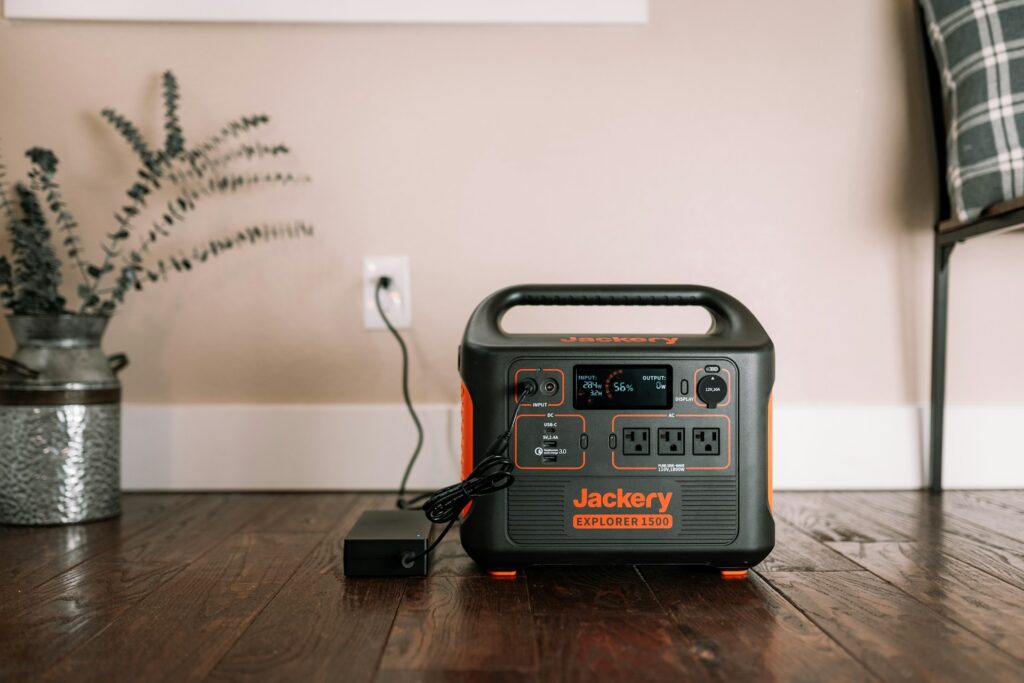
Advantages of Solar Generators
There is a massive range of solar generators available, which offer a wide variety of power outputs, capacities, sizes, weights, and prices, catering to any need or budget. Whether you need a compact, portable generator for a small greenhouse or a more substantial unit for broader use, there’s a perfect match out there.
A key advantage of solar generators over direct solar-powered fans is their energy storage capability. Whilst a solar-powered fan relies on sunlight to operate and cannot function at night (and functions less efficiently during cloudy periods), a solar generator stores the energy generated throughout the day in its battery. This feature ensures your fan continues to run smoothly, providing consistent airflow in your greenhouse regardless of whether it’s night or the sun is obscured by clouds. It offers a reliable, uninterrupted supply of solar-generated power, precisely when you need it.
Solar generators are often purchased as complete kits, which include easy-to-set-up, foldable solar panels. These kits are not just simple to install but incredibly versatile, supporting a range of applications beyond greenhouse fans.

The utility of solar generators extends throughout your garden, powering everything from outdoor lighting to security cameras, water features, and gardening tools, as well as appliances within your home. This versatility means that investing in a solar generator equips you not only for your current needs but also for a sustainable, energy-efficient future.
How To Choose a Solar Generator
When selecting a solar generator for your greenhouse, there are a range of reputable and established brands to choose from, such as BLUETTI, Jackery, EcoFlow, Anker, Zendure, and ACOPower. These brands provide solar generators across a wide spectrum of power outputs and capacities, catering to different needs and preferences.
It’s important to understand the power and capacity you need. The right choice depends on the size of your greenhouse, the type of fan you’re using, and how long you need it to run. The good news is, there are tons of solar generators to choose from which easily cover your greenhouse fan’s power requirements.

How Much Power Do Fans Require?
For regular domestic greenhouses, fans typically have an output range from about 20W for small or basic models, up to around 250W for more powerful or larger fans designed to circulate air in bigger spaces. Most commonly, you’ll find greenhouse fans in the range of 40W to 100W, which are adequate for maintaining air circulation and temperature control in a domestic greenhouse environment. These fans are designed to be energy-efficient while providing sufficient airflow to promote healthy plant growth and prevent issues like mould and mildew.
(In order to calculate the size of fan that you need for your greenhouse, there are online calculators you can use, such as ACF Greenhouses and The Greenhouse Catalog.)
If you’re in the market for a solar-powered heater, however, which has both cooling and heating capabilities (e.g. through different heat settings), you should expect these to have a greater wattage output. Domestic greenhouse heaters typically need between 150W for small spaces to more than 3000W for larger or colder environments. A common range for adequate heating is 1000W to 2500W. Choosing the correct heater depends on your greenhouse size, climate, and plant types. Opting for thermostatically controlled models can help maintain temperatures efficiently, cutting down on energy use.
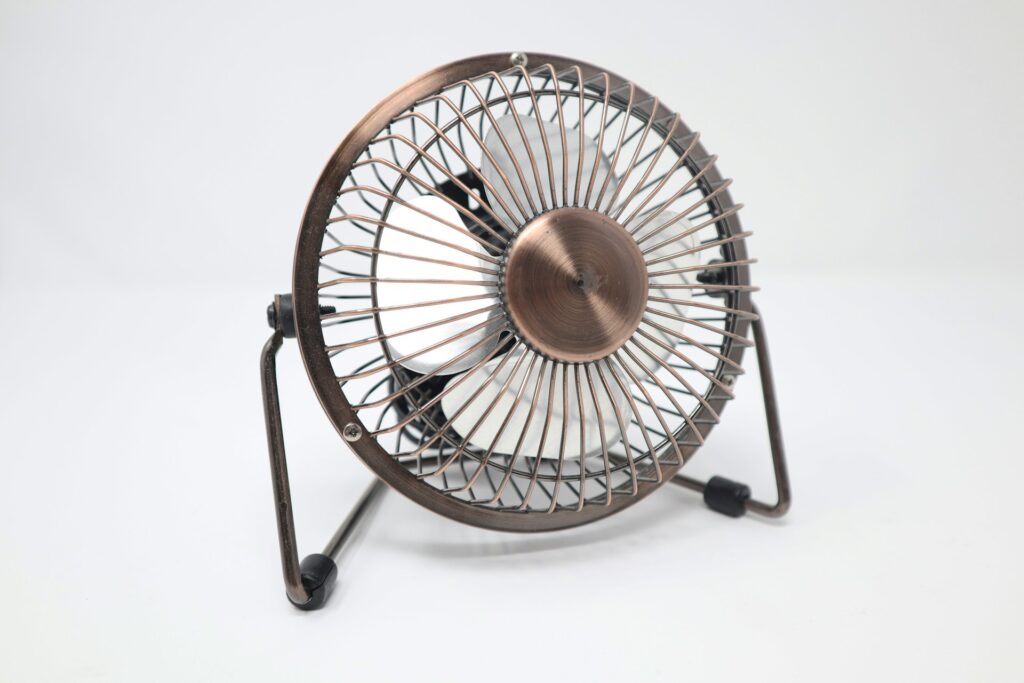
What Main Solar Generator Specs Should I Be Considering?
1. Output (W)
Solar generators come with a wide range of power outputs, from a few hundred watts up to several thousand, and their capacities (battery life) can vary from about 200Wh for smaller models to more than 2000Wh for the larger ones. This variety means you can find one that suits any need, from powering a small greenhouse to handling larger projects.
Most solar generator kits include panels in your purchase, typically between 100W to 200W. Some models also let you choose how many panels you want, giving you control over how fast you recharge based on the sunlight available and your power requirements.
Yes, a solar generator with, say, a 1000W output can safely power a 100W greenhouse fan. Using a generator with more power than you need for a particular device is actually beneficial. It ensures efficient operation without overworking the generator, potentially extending its lifespan (measured in Wh). Plus, it allows you to power more or bigger devices safely without risk of overload. Although not necessary for powering your greenhouse fan, a higher-output solar generator is a smart choice for future-proofing your greenhouse’s energy requirements.
2. Capacity (Wh)
The battery capacity of solar generators, as mentioned briefly above, is another key specification of solar generators. The generator’s battery capacity (i.e. life) is measured in Watt-hours (Wh), and tells you how much energy it can hold. For example, a 1048Wh generator can run a 100W fan for about 10.48 hours before it needs recharging. Knowing a generator’s capacity is important because it affects how long your fan can keep going without a recharge.
3. Recharging Options
Obviously, you’re going to be wanting to power your greenhouse fan for longer than 10.48 hours! This is where recharging comes into play. Most solar generators come with two primary options for recharging: through the solar panels included, or via an AC wall outlet.
- Solar Panel Charging: During sunny days, solar panels are your best bet for recharging. They convert sunlight directly into electricity, refilling your generator’s battery without any additional cost. This method is perfect for maintaining a sustainable energy cycle, though its effectiveness can decrease on cloudy days.
- AC Wall Outlet Charging: For a more consistent and reliable charge, plugging into an AC wall outlet is ideal. This method is particularly useful at night, or on days when sunlight is scarce. If your energy provider offers a dual tariff system, charging your generator at night can be more economical: electricity rates are typically lower during off-peak hours, like at night, allowing you to save on costs while preparing for the next day.
It’s also important to note that if you’re considering using your solar generator to power a heater, heaters consume more energy than fans. This means the generator’s battery will deplete quicker, necessitating more frequent recharges to keep the greenhouse warm.
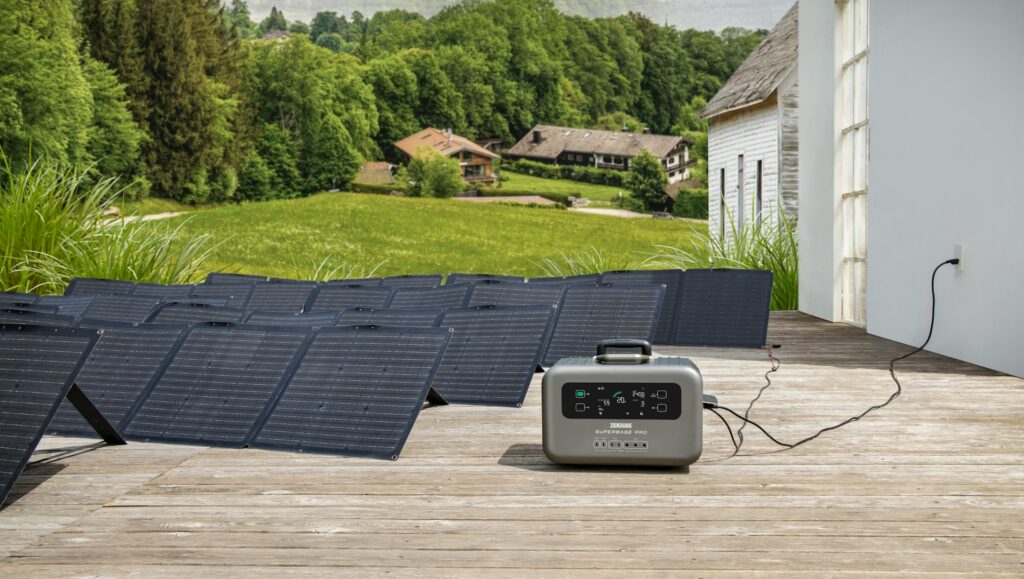
4. Charge Cycle Life
The longevity of your solar generator’s battery is often described by its charge cycle life. For example, a battery with a charge cycle of 3000 before it degrades to 70% or 80% of its original capacity gives you a clear indication of how many recharges you can expect before noticing a drop in performance. Planning your usage around this specification ensures your solar generator remains a reliable source of energy for your greenhouse over time.
By understanding your solar generator’s capabilities and these recharging strategies, you can ensure your greenhouse fan – and other devices – operate efficiently all year round.
Our Top 3 Solar Generator Picks for Your Greenhouse Fan
To help you in your journey, we’ve handpicked three solar generators, each offering distinct advantages. Whether you’re in search of a high-power unit for extensive use, a mid-range model for balanced performance, or a budget-friendly option without compromising on quality, we’ve got you covered. Here are our picks, from the brands EcoFlow, Anker, and Jackery:
High Power:
EcoFlow DELTA Pro (PV400W)
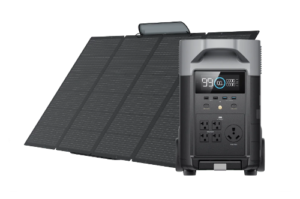
Price (UK): £2,848 (£3,548)
Price (US): $3,899 ($4,798)
Power (W): 3,600
Capacity (Wh): 3,600
Output Ports: AC x4, USB-A, USB-C
Solar Panel Output: 400W
Warranty: 5 years (2 years for panels)
Cycle Life:
3,500 cycles to 80% capacity,
6,500 cycles to 50% capacity
Weight: 99lbs / 45kg
Output: 4 AC outlets, 3600W total (surge 7200W)
Full Recharge Time:
1.9 Hours (AC)
37.5 Hours (12V Car Charger)
1 x 400W panel : 11-22 hrs
2 x 400W panels : 5.5-11 hrs
2 x 400W panels : 3.5-7 hrs
Mid-Range:
Anker 555 Solar Generator (100W Panel)
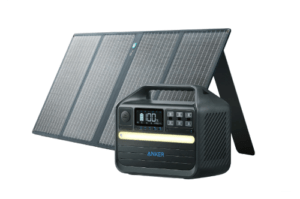
Price (UK): £699 (£1,139) (1x panel)
Price (US): $1,499.99 (2x panels)
Power (W): 1,000
Capacity (Wh): 1,024
Output Ports: AC, USB-A, USB-C
Solar Panel Output: 100W
Warranty: 5 years
Cycle Life:
3,000 cycles to 80%+ capacity
Weight: 11lbs / 5kg
Output: AC outlet, 1000W total
Full Recharge Time:
4.1 Hours (high-speed USB-C ports)
1x 200W panel: 5.5 hrs
Budget: Jackery Solar Generator 500 (80W
Panel)
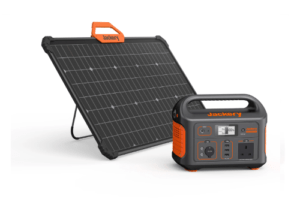
Price (UK): £499 (£759.00)
Price (US): $599
Power (W): 500
Capacity (Wh): 518
Output Ports: AC, DC, USB-A
Solar Panel Output: 80W
Warranty: 2 years
Cycle Life:
500 cycles to 80%+ capacity
Weight: 13.3lbs / 6kg
Output: 500W Inverter (surge 1000W)
Full Recharge Time:
7.5 Hours (AC Adapter)
100W panel: 9.5 hrs (sold separately, or upgrade from 80W to 100W for US product)
- High Power: EcoFlow DELTA Pro For those who need to power large fans or multiple devices, the EcoFlow DELTA Pro stands out. With a hefty 3,600W power and the same capacity in watt-hours, it’s built for sustained use. It can recharge rapidly via AC and supports up to 3,500 cycles to 80% capacity. While its solar panel output is robust at 400W, the unit’s weight of 99lbs might limit its portability. The 5-year warranty offers peace of mind, but the higher price point reflects its premium status.
- Mid-Range: Anker 555 Solar Generator Anker’s 555 offers a balanced compromise with a 1,000W output and a 1,024Wh capacity. It’s much lighter at 11lbs, enhancing its portability for medium-sized greenhouses. The full recharge time with a 200W panel is reasonable, and with a 5-year warranty and 3,000 cycles to 80% capacity, it ensures reliability. It sits comfortably in price and performance between the high-power and budget options.
- Budget: Jackery Solar Generator 500 The Jackery Solar Generator 500 is ideal for smaller setups, offering a 500W output and 518Wh capacity. It’s slightly heavier than the Anker at 13.3lbs but remains portable. With a modest 80W solar panel output and a shorter cycle life of 500 cycles to 80% capacity, it’s designed for those with lighter energy needs. The recharge time is longer, but its affordability makes it accessible, backed by a 2-year warranty.
Each of these solar generators has its strengths, from the robust EcoFlow suitable for high-demand situations to the lightweight and versatile Anker, down to the budget-friendly Jackery for basic needs. Your choice will depend on the specific demands of your greenhouse ventilation and your budget.
Conclusion
Despite the increasing uptake of solar solutions in today’s climate, it remains a frustrating reality that solar-powered products, such as greenhouse fans, can be hard to come by – particularly when it comes to finding reputable sellers online. That’s why we think solar generators are the perfect versatile investment for your greenhouse needs. Their ability to store energy allows for round-the-clock operation, vital for the delicate ecosystem of a greenhouse. With the capacity to charge even while in use, solar generators ensure your greenhouse ventilation is never compromised. What’s more is that the brands mentioned in this article – such as BLUETTI, Jackery, EcoFlow, and more – are regarded as highly trustworthy brands in the solar consumer market, so you can rest assured that the quality of their products is worth your investment.
We hope this article has provided some useful advice on your pathway to selecting the best solar-powered solutions for your greenhouse fan needs.
(Want more info on choosing the right brand? Check out some of our brand comparisons, such as Bluetti vs EcoFlow, or Bluetti vs Jackery.)
FAQs
The size of the solar generator you need depends on the wattage of your greenhouse fan and how long you want it to run. If you have a 100W fan and wish to run it for 8 hours a day, you’ll need a generator with at least 800 watt-hours (Wh) of capacity. Always choose a generator with a bit more capacity than you think you’ll need to account for energy losses and varying sunlight conditions.
The frequency of recharging your solar generator depends on the generator’s capacity and the energy usage of your fan. For a 100W fan and a solar generator with an 800Wh capacity, you would typically need to recharge it after every 8 hours of fan operation. However, if you run the fan for fewer hours per day or if the generator has a higher capacity, you’ll need to recharge it less often. You can charge it with solar panels during the day, or by plugging it into a wall AC socket at night.
Yes, you can simultaneously charge your solar generator with solar panels and use it to power your greenhouse fan. This is a common setup for maintaining continuous operation. However, the efficiency of charging may be reduced if the power draw from the fan is high, so ensure your solar panel array provides enough output to both run the fan and charge the battery effectively.
Yes, a solar generator can run a greenhouse fan at night as long as it has stored enough power in its battery during the day. Make sure the generator’s capacity is sufficient to cover the fan’s energy consumption for the hours you’ll need it to run after dark.
Solar generator batteries typically last for several years. Most have a charge cycle life, indicating how many times you can recharge the battery before its efficiency decreases, usually around 3000 cycles to 70-80% capacity. Proper maintenance can help extend the battery’s lifespan.
Yes, solar generators can power greenhouse heaters, but heaters generally require more energy than fans. You’ll need to consider the heater’s wattage and choose a generator with a higher capacity to ensure it can handle the load, especially if you plan to run the heater for extended periods.

Solar Trek is all about breaking down information about solar-powered brands and products into a helpful, easily digestible format. All of our content is totally objective, aimed at helping you to make the best purchasing decisions for your solar needs. If you click our links and make a purchase, we may earn some commission at no extra cost to you, but this does not interfere with our goals of providing 100% helpful, informative, and objective information.




